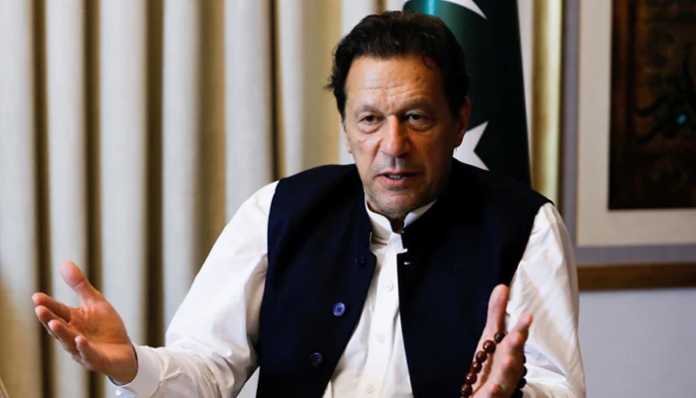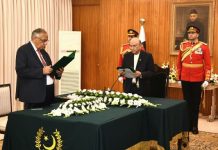ISLAMABAD, JAN 9 (DNA): The cipher that former prime minister Imran Khan claims as proof of US involvement in regime change is not a single-page document but includes 11 points, an insider privy to the details revealed.
Nine points address trade and human smuggling issues, while the two perceived as threats are reportedly remarks by US official Donald Lu in response to Pakistan’s ambassador’s queries.
This document has fueled a political debate and formed the basis of Pakistan Tehreek-e-Insaf (PTI) founder Khan’s entire narrative against the alleged conspiracy.
On January 3, 2025, the former prime minister again accused ex-COAS General (retd) Qamar Javed Bajwa and US President Joe Biden of involvement in his removal through a vote of no-confidence.
He termed it blatant interference, repeating his claim of a conspiracy behind his government’s ouster.
Background briefings and interviews with officials and former ministers reveal the cipher was not as portrayed by Khan. Even during the March 27 National Security Committee meeting, the services chiefs called it a harmless communique.
However, Khan had already decided to use it politically to build a narrative that his government was toppled under the US influence.
An informed source revealed that US State Department official Donald Lu attended a farewell lunch at Pakistan’s Embassy in Washington. Three US officials and four Pakistani officials sat at the same table.
During the discussion, Pakistan’s ambassador talked about the ongoing relations between Pakistan and the US administration.
Sources revealed that after the event, Pakistan’s ambassador sent a cipher to the Foreign Office summarising an 11-point discussion with Donald Lu.
Nine points focused on trade and illegal immigration. For instance, one point mentioned Lu discussing the reasons behind Pakistan’s low rice export volume to the US that year. This highlights the broader context of the meeting, contrary to the perception of a politically charged conspiracy.
“The cipher contained two points later used by Imran Khan to build his political narrative. Both points were raised by Pakistan’s ambassador with Donald Lu, who responded by complaining [about] the Pakistani government’s approach towards the Biden Administration. These replies were misinterpreted as threats to support Khan’s claims of interference,” revealed a source privy to the development.
“One of the points in the cipher was that Pakistan’s ambassador informed Donald Lu about his transfer to Belgium and mentioned that Lu could not arrange a meeting between Pakistan’s prime minister and US President Joe Biden,” revealed the source.
“In response, Donald Lu complained that Pakistan’s prime minister openly criticised the US administration and supported the Taliban. This has damaged relations between the two countries, and reviving these ties will take time,” the source added, sharing details about the conversation mentioned in the cipher.
“The ambassador again reminded Donald Lu that President Biden has met or called many world leaders but hasn’t even phoned prime minister Imran Khan,” revealed the source.
“In response, Lu complained that prime minister Khan often criticised the US and tweets in support of the Taliban.
Lu said: “We need to work together to revive relations and normalise ties between the two countries, both now and after the vote of no-confidence,” the source added, sharing details from the cipher.
“Donald Lu remarked about the vote of no-confidence because political parties had already announced plans to move it against Imran Khan,” the source explained.
“There was no threat of regime change in the cipher, as claimed by Imran Khan. How could a mid-ranking official of the State Department threaten a sovereign country?” the source added.
“The cipher passed through several hands, including the deputy secretary, joint secretary, and secretary of Foreign Affairs, foreign minister, and finally the prime minister.”
Another source revealed that opposition parties tabled the no-confidence motion on March 8, while the cipher was received by the Foreign Office in the night of March 8.
“It was then handed over to foreign minister Shah Mehmood Qureshi on March 9, who presented it to prime minister Imran Khan,” the source added.
A source privy to post-cipher developments revealed that on March 12, 2022, Khan invited trusted journalists and excitedly shared: “I have found something very important (the cipher). Now I will see how they oust me through a vote of no-confidence motion.”
The sources further revealed that a copy of the cipher was sent to the GHQ, where then-army chief General Bajwa received it on the evening of March 12.
The next day, March 13, Bajwa visited Kamra Airbase for a plane handover ceremony, taking the cipher with him since prime minister Khan was also invited. “The Army Chief discussed the cipher, but Imran Khan ignored it, calling it a routine matter,” the sources added.
Interestingly, on March 16, the same Donald Lu, later accused of being behind the regime change, was invited by Pakistan’s Embassy in Washington for another event.
He attended via Zoom, and the meeting was cordial. “If he had been involved in any regime change, why Imran Khan’s government would invite him again after the alleged threats,” the source questioned.
The source further revealed that after the cipher, between March 8 and March 27, Khan sent three ministers to convince the then-army chief to accept an extension in his tenure.
“The first minister visited on March 14, the second on March 17, and the third a few days later. All offers were rejected thrice,” the source added.
From March 22 to 23, a US delegation including Under Secretary Uzra Zeya and Tom West, US Special Representative for Afghanistan, attended the OIC Foreign Ministers conference in Islamabad.
Khan’s government not only welcomed them but also held official meetings with the US officials.
On March 26, 2022, Khan called the then-army chief and DG ISI, asking them to negotiate with opposition parties to withdraw their no-confidence motion in exchange for an early election.
“The sources claim that both military officials met political party leaders at Margalla Mess, Islamabad, on the night of March 26 and conveyed Khan’s message, but the parties’ heads refused his offer,” the sources added.
The day after opposition parties rejected Khan’s offer of early elections, he convened a National Security Committee meeting on March 27 to discuss the cipher in detail.
“The majority of the committee, including all services chiefs and the Chairman Joint Chiefs of Staff Committee, termed the cipher a harmless and least important document,” the sources revealed.
Later that evening, Khan addressed a public rally at Parade Ground, Islamabad, and decided to use the cipher politically after all his options, including offering an extension to the army chief and calling for early elections, were rejected.
Even Khan’s close aides and cabinet members believed there was no American involvement in ousting his government.
Recently, Shafqat Mehmood, a member of Khan’s cabinet, confirmed in an interview that the US government was not involved in toppling the government.
“When politicians build narratives in the public, it doesn’t mean they are always based on truth. This is what they call politics,” he said.

















